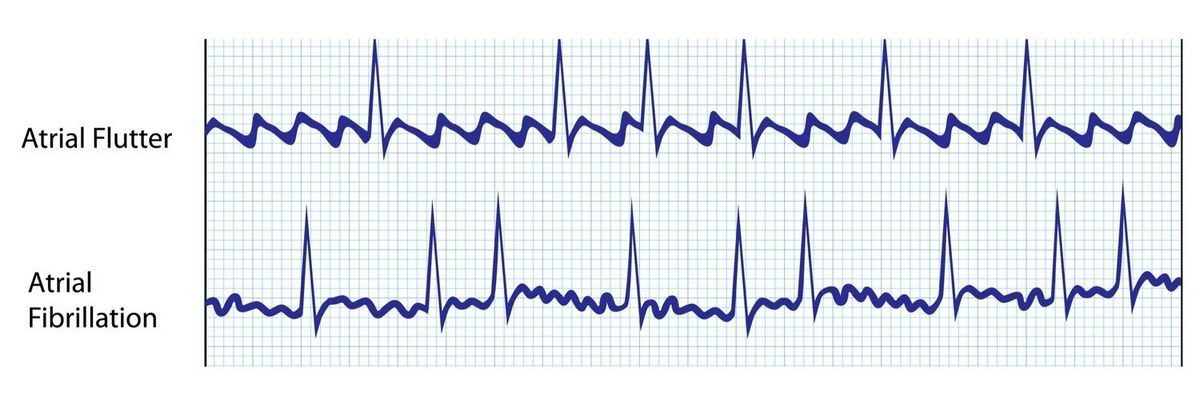
Contents
- 1 Atrial Flutter vs. Atrial Fibrillation: Similarities & Differences
- 1.0.1 Which heart condition is more serious?
- 1.0.2 Are atrial flutter, atrial tachycardia, and atrial fibrillation the same thing?
- 1.0.3 What are the differences in how atrial flutter and AFib affect the heart (ECG wave strip patterns)?
- 1.0.4 What are the differences between how these two heart conditions feel (symptoms)?
- 1.0.5 Do the causes and risk factors for atrial flutter and atrial fibrillation differ?
- 1.0.6 What is the difference between the treatments for atrial flutter and atrial fibrillation?
- 1.0.7 From
- 1.0.8 Can either of these conditions be prevented?
- 1.0.9 What is the prognosis for someone with atrial fibrillation or atrial flutter?
Atrial Flutter vs. Atrial Fibrillation: Similarities & Differences
Atrial flutter is a type of atrial tachycardia that results in an arrhythmia where the atria beat too quickly in a fast, usually regular, rhythm.
Atrial fibrillation is another type of atrial tachycardia closely related to atrial flutter. However, the arrhythmia that occurs in AFib is much more chaotic and results in a fast and usually very irregular heart rhythm or an atypical and irregular ventricular rate that can affect heart health.
Which heart condition is more serious?
Both heart diseases have the potential of becoming serious. However, many doctors and other health care professionals consider atrial flutter to be less serious than atrial fibrillation because flutter symptoms tend to be less severe and flutter waves have less risk of clot formation.
Flutter waves also tend to revert back to sinus rhythm spontaneously more often in some patients.
Are atrial flutter, atrial tachycardia, and atrial fibrillation the same thing?
Atrial flutter, atrial fibrillation (AFib), and atrial tachycardia are not the same things. However, all three terms have in common a rapid heart rate that can be felt when a person feels their pulse. Atrial tachycardia is a general term that indicates a cardiac condition where the rate of contraction of the heart’s atria is fast and not normal but does not describe the type of heart rhythm. Atrial tachycardia is also termed supraventricular tachycardia and is a type of cardiac arrhythmia that usually results in a fast heartbeat, even at rest.
In contrast, atrial flutter and AFib are the main types of atrial tachycardia. They are distinguished by the different patterns of abnormal electrical impulses generated in the atria; a regular pattern for atrial flutter and an irregular pattern for AFib. Both are considered abnormal heart rhythms not good for heart health, and both have the potential to decrease the overall health of the patient.
QUESTION
What are the differences in how atrial flutter and AFib affect the heart (ECG wave strip patterns)?
What do ECG and electrical conduction of a normal heart look like?
Atrial flutter ECG
Atrial flutter is a health condition that causes the atria of the heart to have conduction or electrical problems resulting in a regular pattern that causes the atria to beat at a rapid rate of about 240-360 beats per minute (bpm). The atrial flutter waves are regular and on an electrocardiogram (ECG, EKG) are seen as P waves in a regular pattern (small P waves in succession with short or no intervals between each wave). Often, the flutter waves are not completely transferred through the AV node to the ventricular heart chambers so occasionally electrical conduction blocks occur and produce a 2:1, 3:1, or 4:1 ventricular contraction rate. The most common atrial flutter occurs when the atria beat at a rate of 300 bpm and the ventricular contraction rate is 150 bpm (2:1 conduction). Infrequently, some patients with flutter waves may also have bradycardia because the heart’s ventricles are not receiving most of the flutter P waves. Flutter waves may come and go spontaneously in some patients. Atrial flutter is the second most common tachyarrhythmia.
AFib ECG
Atrial fibrillation is the most common tachyarrhythmia. The incidence is about 27-28 per 1000 person-years. AFib is a heart disease that causes the atria of the heart to have conduction or electrical problems that result in a chaotic, irregular production of irregular QRS waves with no P waves. In contrast to flutter waves, the abnormal conduction creates irregular, rapid QRS waves, some of which are conducted to the heart ventricles through the AV node. This results in the heart having ventricular contractions that are irregular, variable ineffective blood pumping, and usually range from about 100-175 bpm.
What do ECG and abnormal electrical conduction of atrial fibrillation look like?
ECG of the heart’s abnormal electrical problem in AFib
What are the differences between how these two heart conditions feel (symptoms)?
The difference between atrial flutter and AFib in terms of feeling is very similar. However, if the pulse is regular even though it’s fast, the problem is probably atrial flutter. If the pulse is fast and irregular, then the person is more likely to have AFib.
Although some people have no symptoms and cannot feel the arrhythmias, common clinical symptoms of both arrhythmias are:
- Palpitations (person feels their heart beating or pounding)
- Fatigue
- Shortness of breath
- Feeling like you are going to faint
- Blurry vision
- Lightheadedness
- Heart skipping beats
Serious symptoms may include:
- More severe shortness of breath
- Sweating
- Chest pain
- Fainting or loss of consciousness
Do the causes and risk factors for atrial flutter and atrial fibrillation differ?
Any damage to the electrical pacemaker in the heart’s atrium may result in flutter or fibrillation QRS waves. No one knows for sure what triggers either atrial flutter or AFib. However, many doctors suggest that the risk factors for these two arrhythmias are essentially the same and function as probable causes of the two heart problems. Unfortunately, there are many risk factors for flutter and fibrillation:
- Hypertension (high blood pressure)
- Diabetes
- Heart failure
- Obesity
- Any serious acute illness (myocardial and/or ischemic heart disease, cardiomyopathy)
- Advanced age
- Recent surgery
- Chronic lung disease
- Binge alcohol intake or continual heavy alcohol use
- Hyperthyroidism
- Stress
- Wolff-Parkinson-White syndrome (20% may develop flutter and 7% may develop fibrillation)
By clicking "Submit," I agree to the MedicineNet Terms and Conditions and Privacy Policy. I also agree to receive emails from MedicineNet and I understand that I may opt out of MedicineNet subscriptions at any time.
What is the difference between the treatments for atrial flutter and atrial fibrillation?
Because these two arrhythmias are similar in their potential causes, the American Heart Association suggests the same treatment guidelines for both AFib and atrial flutter. The goal of these treatments is to return the heart to a normal condition and remove signals to generate arrhythmias.
In some individuals, vagal maneuvers or administration of an IV dose of adenosine may stop atrial flutter. They do not work well for treatment or conversion or stoppage of AFib. However, other medications and procedures are virtually identical (dosage may vary) for the treatment of flutter and fibrillation according to the American Heart Association. Medications include antidysrhythmics and beta-blockers. Anticoagulants are used to prevent blood clots.
Procedures include electrical cardioversion, ablation (radio wave ablation, laser ablation, freezing ablation techniques) of abnormal atrial tissue generating electrical impulses, and other surgical techniques such as generation of scar formation (Maze procedure) to block or eliminate abnormal P wave or irregular QRS complex formation in some individuals that are refractory to more common treatments.
From
Heart Health Resources
- AFib: Could You Be Living Better?
- HCM: Is It All In The Family?
Featured Centers
- What Are the Best PsA Treatments for You?
- Understanding Biologics
- 10 Things People With Depression Wish You Knew
Can either of these conditions be prevented?
Unfortunately, these two problems are difficult to prevent because there are many potential causes and risk factors associated with them. Some risk factors you cannot change; for example, age over 60, family members with one of the conditions, and being a white male. However, most organizations like the American Heart Association publish suggestions to reduce risk, which include:
- Get regular physical activity.
- Eat a heart-healthy diet, low in salt, saturated fats, trans fats, and cholesterol.
- Avoid excessive amounts of alcohol and caffeine.
- Don’t smoke.
- Maintain a healthy weight.
- Treat underlying diseases like high blood pressure, sleep apnea, hyperthyroidism, diabetes, or any disease of the heart.
- Individuals with risk factors they cannot change are especially encouraged to reduce risk by following these suggestions.
What is the prognosis for someone with atrial fibrillation or atrial flutter?
The prognosis and life expectancy for patients with atrial flutter or atrial fibrillation depend on the patient’s underlying condition. Individuals with complicated medical conditions and poor responses to medications or procedures have a poorer prognosis.
- Patients with atrial flutter may have a slightly better prognosis than patients with atrial fibrillation.
- However, patients with arrhythmia that undergo ablation have an excellent prognosis with a very low recurrence rate. Ablation can allow a patient to have a normal rhythm with a normal ventricular rate and a return to normal heart health.


